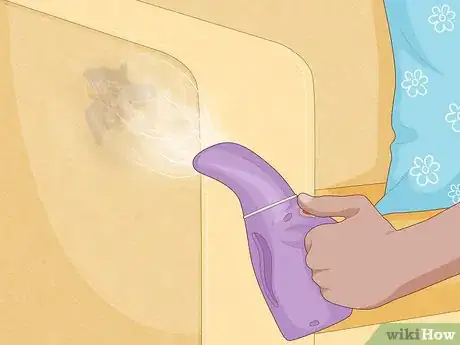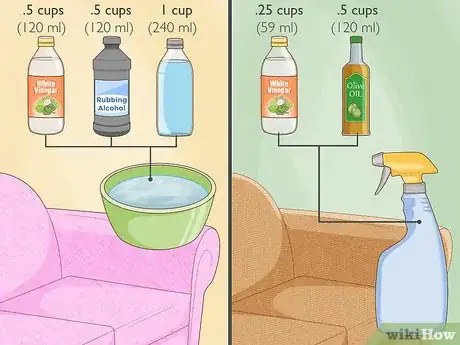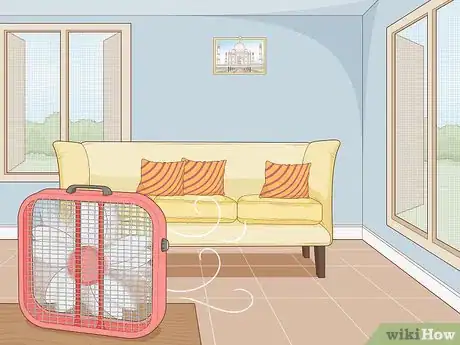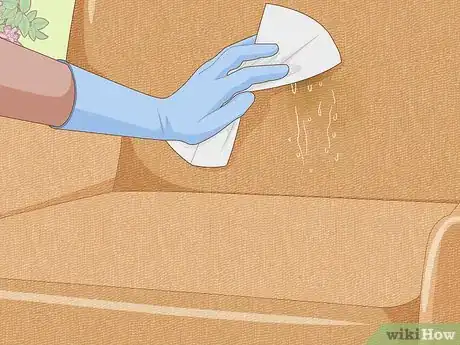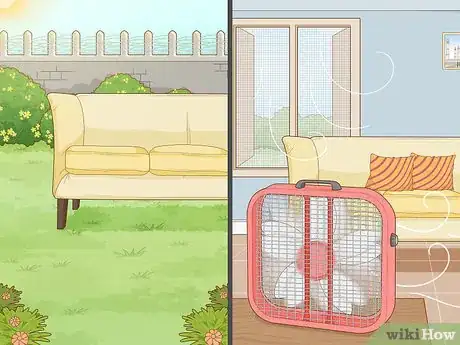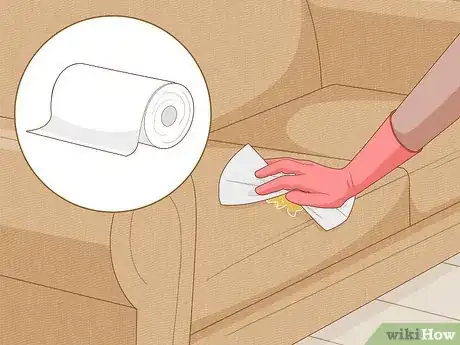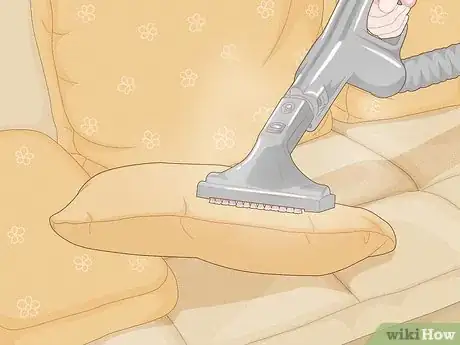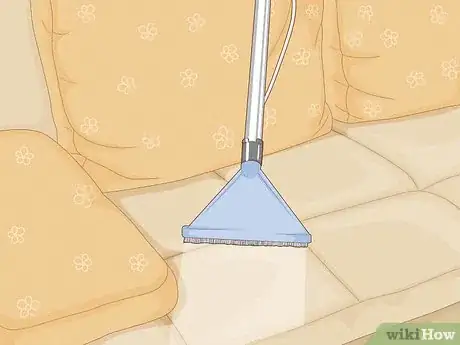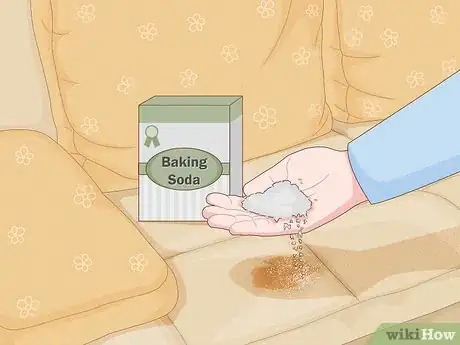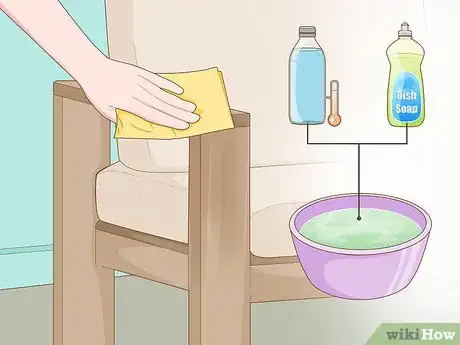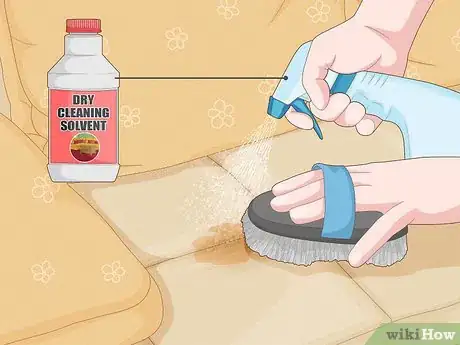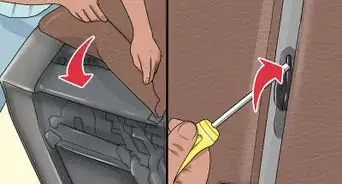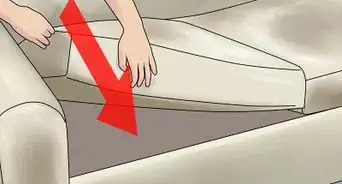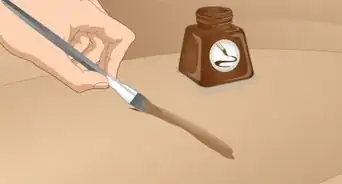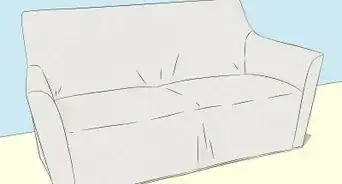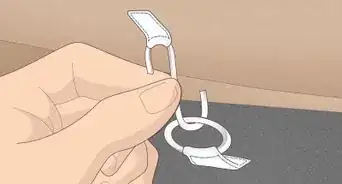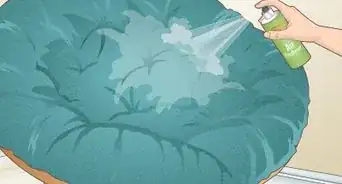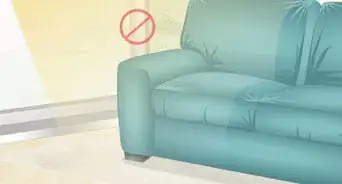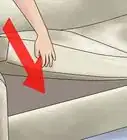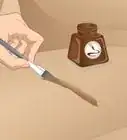This article was co-authored by Guy Peters. Guy Peters is the Owner of MOP STARS Cleaning Service, a complete house cleaning service for residential and commercial clients, based in Denver, Colorado. Founded in 2014, MOP STARS provides regular, move in/out, deep, and commercial cleaning services. Guy has a BA in Finance from the California State University - Sacramento and an MBA from Cornell University.
There are 10 references cited in this article, which can be found at the bottom of the page.
This article has been viewed 157,716 times.
Many couches start to smell over time as dirt, grease, hair, and food crumbs accumulate. Couches can also get a quick blast of stink if a pet or child pees on them, or if you let your friend with stinky feet sleep on your sofa for the night. Whatever the reason, it’s easy to remove odors from your couch. First, check if your couch can tolerate water-based cleaners. If it can, make your own deodorizer from white vinegar and spray the couch. If your couch can’t tolerate water, vacuum the couch and use baking soda and other dry solvents to get it smelling fresh.
Steps
Using Water-Based Deodorizers
-
1Check the care tag to see what your couch is made out of. Couches can be made of fabric, microsuede, polyester or leather, and they have different cleaning requirements. The care tag will say either W, S, SW, or X.[1]
- W: wet/water cleaning only. You can use water or vinegar in your cleaning solution.
- S: dry solvent cleaning only. Use a dry solvent, like baking soda, or have professionals dry clean your couch.[2]
- SW: solvent and/or wet cleaning. Use a dry solvent, or vinegar or water.
- X: professional cleaning or vacuuming only.
-
2Wash removable covers in the washing machine. If your couch pillows and cushions have removable covers, you’re in luck. As long as your couch’s care tag says W or SW, you can just toss the covers in the clothes washer.[3]
- If your cushions don’t have removable covers, vacuum them with a hand-held vacuum, or a brush extension on a regular vacuum cleaner.[4]
Advertisement -
3Spot-clean stains with steam. Check the care tag of the couch to verify if you can steam clean it. If the care tag says that you use water to wash your couch, then it’s safe to use steam. Set your iron on the steam setting and run it over stained places on the couch.[5]
- Steam can dissolve a lot of stubborn materials and leave your couch looking clean.
-
4Mix your own deodorizer with white vinegar. Check your couch’s care tag if you’re not sure what material it is, because you’ll need to make a slightly different deodorizer depending on what type of upholstery you have. For all of them, mix the ingredients in a spray bottle, and make sure to use plain white vinegar, not white wine vinegar.
- For fabric upholstery, mix .5 cups (120 ml) white vinegar, .5 cups (120 ml) rubbing alcohol, and 1 cup (240 ml) of water.[6]
- For leather upholstery, mix .25 cups (59 ml) white vinegar and .5 cups (120 ml) olive oil in a spray bottle.[7]
- For synthetic upholstery, mix .5 cups (120 ml) white vinegar, 1 cup (240 ml) of warm water, and a splash of dish soap in a spray bottle.[8]
- For any of the mixtures, you can add some drops of lavender essential oil or lemon juice to freshen up the scent. Give the bottle a good shake, and you’re ready to spray.
- You can also use a store-bought deodorizer if you don't feel like making your own. Products like Febreze work on most couch materials (except for suede and leather).
-
5Open windows and turn on a fan. The ingredients you’ll be spraying are not toxic at all, but the smell can be a bit overwhelming if you spray them in a closed-up room. To make the experience more pleasant, crack open your windows and turn on a fan.[9]
- If you can, deodorize your couch on a sunny day, so that you can have the windows open, and so the couch will dry more quickly.
-
6Spritz the couch lightly with deodorizer. Hold the spray bottle about 1 foot (30 cm) away from the couch as you spray, so that you don’t accidentally soak the upholstery. You just want to lightly spritz it. If there is one spot in particular that’s emitting the bad odor, focus on that part of the couch. If you can’t localize the bad odor, then spray the entire couch.
- The vinegar might leave a lingering smell, but after a few hours it will dissipate.[10]
-
7Wipe the couch dry with a clean rag. Use a soft, dry, absorbent cloth. With gentle blotting motions, sop up any liquid that has not absorbed or evaporated. If the couch is leather, you can use wiping motions, because the leather is more water-resistant.[11]
- If your couch is made of fabric or velvet, it’s best to blot rather than wipe to avoid damaging the upholstery.[12]
-
8Dry the couch with sunlight or a fan. You don’t want mildew to grow on damp couch cushions, so make sure the couch dries completely. If you’re in a dry climate, just let sunlight come through the window and it will dry your couch in no time. If you’re in a humid climate, point a box fan at the couch for a few hours to speed up the process.[13]
- If you’ve tried all these techniques, and your couch still stinks, consider calling a professional couch cleaner.
Deodorizing without Water
-
1Blot up puddles and stains quickly with paper towel. If something really smelly has just gotten on your couch, like pet pee or blood, the first thing to do is to blot it up as quickly as possible with paper towel or a clean rag. This will give the stinky stuff less time to absorb into your couch.
- Use dabbing, blotting motions, instead of rubbing motions, so that you don’t rub it further into the couch.
-
2Vacuum the couch cushions and pillows. If your couch cushions don’t have removable cushions, or can’t touch water, just run the brush extension of your vacuum cleaner over the cushions, or use a hand-held vacuum cleaner. That’s the same way you’ll clean the body of your couch. Make sure to clean both sides of each cushion![14]
- If the cushions don’t come off your couch, just vacuum the whole couch.
-
3
-
4Sprinkle baking soda on stains to remove odors. Pour some baking soda into your palm and then sprinkle it over the stained spot. The baking soda can do double-duty, dissolving unsightly stains and demolishing nasty odors.[17]
- Let the baking soda sit on the stain for at least 15 minutes, and then vacuum up the baking soda.[18]
-
5Clean non-upholstered parts of the couch with a damp rag. Even if the upholstery can’t be cleaned with water, you can still clean the non-upholstered parts of the couch with water. Mix a solution of warm water and dish soap and put it on a cleaning rag. Wipe the sofa feet or any other metal, wood, or non-fabric part of the couch.[19]
- Use a clean, dry, absorbent rag to dry the parts you washed.[20]
-
6Purchase a dry cleaning solvent and clean your couch. If you have tried all of the above techniques, and your couch is still stinky, you should try dry-cleaning it. You can buy dry cleaning solvent from a home repair store or online. Ventilate your work area by opening up windows and setting up a fan. Put the solvent onto a clean towel and brush it over the upholstery.[21]
Things You’ll Need
Using Water-Based Deodorizers
- Iron
- White vinegar
- Rubbing alcohol
- Olive oil
- Dish soap
- Lavender oil (optional)
- Lemon juice (optional)
Cleaning without Water
- Paper towel or dry rag
- Hand-held vacuum or vacuum brush extension
- Lint roller
- Baking soda
- Dry cleaning solvent
Warnings
- Check the care tag before you decide which cleaning supplies to use.⧼thumbs_response⧽
- Spot-test your cleaner on a small area before you clean the whole couch. That way you won’t accidentally stain all of the upholstery!⧼thumbs_response⧽
- Dry-cleaning releases fumes, so ventilate your room well when you use a dry solvent.⧼thumbs_response⧽
- Before cleaning couch cushions and their covers, identify what materials (cotton blend, linen, foam, etc.) they're made of and how to wash those materials properly.⧼thumbs_response⧽
References
- ↑ https://deadspin.com/help-my-couch-is-humiliating-510441973
- ↑ https://www.esquire.com/style/news/a44009/clean-couch/
- ↑ https://www.apartmenttherapy.com/tips-on-how-to-spot-clean-old-or-setin-stains-on-upholstery-208738
- ↑ https://www.apartmenttherapy.com/tips-on-how-to-spot-clean-old-or-setin-stains-on-upholstery-208738
- ↑ https://www.apartmenttherapy.com/tips-on-how-to-spot-clean-old-or-setin-stains-on-upholstery-208738
- ↑ https://hellonest.co/diy-upholstery-spray/
- ↑ https://www.diynetwork.com/how-to/maintenance-and-repair/cleaning/how-to-clean-a-couch
- ↑ https://www.diynetwork.com/how-to/maintenance-and-repair/cleaning/how-to-clean-a-couch
- ↑ https://hellonest.co/diy-upholstery-spray/
- ↑ https://www.esquire.com/lifestyle/advice/a46154/how-to-remove-smells-from-couch/
- ↑ https://www.esquire.com/lifestyle/advice/a46154/how-to-remove-smells-from-couch/
- ↑ https://www.architecturaldigest.com/story/how-to-clean-velvet-furniture
- ↑ https://www.diynetwork.com/how-to/maintenance-and-repair/cleaning/how-to-clean-a-couch
- ↑ https://www.apartmenttherapy.com/tips-on-how-to-spot-clean-old-or-setin-stains-on-upholstery-208738
- ↑ https://www.diynetwork.com/how-to/maintenance-and-repair/cleaning/how-to-clean-a-couch
- ↑ https://www.diynetwork.com/how-to/maintenance-and-repair/cleaning/how-to-clean-a-couch
- ↑ https://www.familyhandyman.com/cleaning/how-to-clean-furniture-and-fight-odors-without-chemical-cleaners/view-all/
- ↑ https://oconto.extension.wisc.edu/files/2011/02/Baking-Soda.pdf
- ↑ https://www.diynetwork.com/how-to/maintenance-and-repair/cleaning/how-to-clean-a-couch
- ↑ https://www.diynetwork.com/how-to/maintenance-and-repair/cleaning/how-to-clean-a-couch
- ↑ https://www.bobvila.com/articles/how-to-clean-upholstery/
- ↑ https://www.bobvila.com/articles/how-to-clean-upholstery/
- ↑ https://www.bobvila.com/articles/how-to-clean-upholstery/


